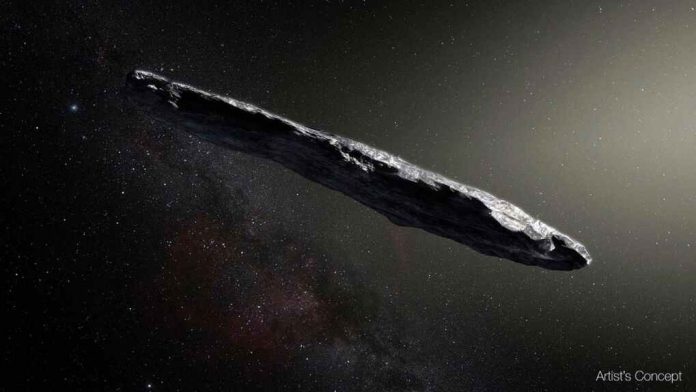The exact nature of the bizarre interstellar object ‘Oumuamua remains a mystery. There’s been no shortage of ideas, but now astronomers at Yale and the University of Chicago have proposed that it’s a brand new type of object: a hydrogen iceberg.
The new study was accepted for publication in The Astrophysical Journal Letters, and was published as a preprint at ARXIV.ORG.
WHAT MAKES ‘OUMUAMUA SO WEIRD? ‘Oumuamua was originally classified as a comet, but later observations showed no cometary activity as it lacks the telltale coma, or envelope surrounding a comet’s core, and tail of gas and dust. It also has a dry surface more akin to that of rocky asteroids.
However, it also could not be an asteroid given its acceleration as it sped by the Sun. ‘Oumuamua slingshotted past the Sun at a speed of 196,000 miles per hour — which is too fast to be explained by the pull of the Sun’s gravity alone.
‘Oumuamua is also highly elongated, believed to stretch across 900 feet in its longest dimension.
The team behind the new study sought out a strange cosmic tale to explain an equally strange cosmic being.
“We developed a theory that explains all of ‘Oumuamua’s weird properties,” Gregory Laughlin, a professor of astronomy at Yale University, and lead author of the new study, said in a statement.
The study suggests that ‘Oumuamua is composed of a giant block of hydrogen ice that was spawned from a massive molecular cloud. These clouds act as giant stellar nurseries, stretching across hundreds of light years, with enough dense gas and dust within them to birth thousands of stars.
Hydrogen is the most abundant element in the universe, making up about 75% of all normal matter and fueling the formation of new stars. However, it is rarely observed in solid form.
For hydrogen to solidify, it would need extremely cold temperatures.
Molecular clouds happen to be very cold, with temperatures ranging between -440 to -370 degrees Fahrenheit.
That’s cold enough to freeze hydrogen and turn it into solid.
Therefore, the study suggests that hydrogen ice blocks like ‘Oumuamua could form in the icy cores of molecular clouds, and there could be a lot more of them out there.
“As ‘Oumuamua passed close to the Sun and received its warmth, melting hydrogen would have rapidly boiled off the icy surface, providing the observed acceleration and also winnowing ‘Oumuamua down to its weird, elongated shape — much as a bar of soap becomes a thin sliver after many uses in the shower,” Laughlin said.
If this theory holds true, then ‘Oumuamua is not only the first interstellar object observed by scientists, it would also be the first hydrogen iceberg that they have seen flinging through space. And observing more of these objects could help scientists unravel the mysteries of star and planetary formation in the early universe.
“Their presence would be an accurate probe of the conditions in the dark recesses of star-forming clouds,” Laughlin said. “And provide a critical new clue for understanding the earliest phases of the still-mysterious processes that generate the birth of stars and their accompanying planets.”















